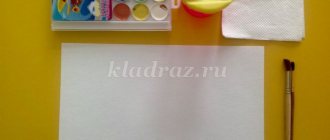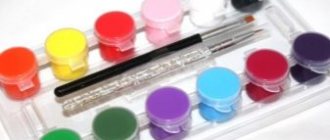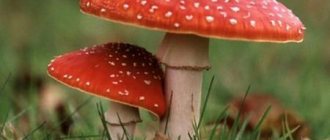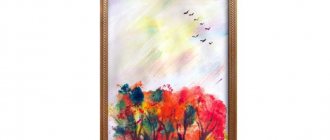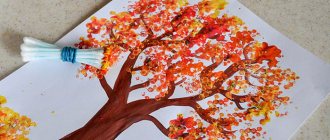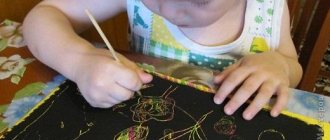Topic: Drawing an autumn forest
For work you need to prepare: - gouache paints; - white A4 album sheet; - a flat, wide brush (for example, No. 12), - fallen leaves from different trees.
How to draw an autumn forest with children using the technique of leaf prints on paper: step-by-step description
Step 1. Draw the sky on the background.
Let's start with decorating the background. Place the A4 size sheet horizontally. Dip the brush into white and blue paint and, moving from left to right, paint the sky and blur it a little with water. Going down the sheet, we try to take more white paint onto the brush than blue. The sky can be drawn on 1/4 sheet.
Step 2. Draw the earth on the background.
Invite the children to remember what colors autumn has? Let them think about how old trees differ from young ones? What trees will they depict in the drawing? Let's paint the ground with fallen leaves using brown-green paints by moving the brush from left to right.
Step 3. Draw a tree using the technique of leaf prints on paper.
Choose a piece of paper you like, preferably a large one. We paint it on the reverse side with paint of any color in accordance with the colors of autumn. This is an important nuance, since the veins on the back of tree leaves are more pronounced, which means they will give us a more beautiful print.
Reminder: In this painting technique, the paint should be thick enough. Do not wet the brush too much in water, otherwise the print will be smeared.
Also paint the tail of the leaf.
Then you need to take a leaf, place it carefully on the prepared background in the background so that there is no shift of the leaf on the paper. Cover the top of our sheet with a paper napkin. It will protect your work from smearing the paint that has come out from under the piece of paper. Next, you need to press the napkin with your palm or lightly stroke it with your fist.
Remove the napkin. Carefully remove the leaf by the tail.
So the first painted tree appeared in our autumn forest!
Step 4. We draw large old trees with leaf prints.
Similarly, we draw several more trees with prints of different large leaves and paints of different colors. These are old trees, they are larger in size. Try coloring the leaves in several colors. This is what happened to four-year-old Nastenka.
Step 5. We draw young trees and bushes with imprints of leaves.
Now let's select a few smaller leaves - these will be young trees and shrubs. Let's paint them with different autumn colors and make prints in the foreground. Thus we get a landscape - an autumn forest. This is the autumn forest seven-year-old Lisa painted with leaf prints.
Drawing an autumn landscape using an unconventional technique
Unconventional drawing for children from 5 years old. Autumn.
Master class on drawing. Autumn landscape.
Goal: creating a drawing on the theme “Autumn” using an unconventional method of drawing: using a cotton swab. Objectives: 1) open up space for children's imagination; 2) create a drawing using gouache, cotton swabs, and a painting brush with stiff bristles; 3) development of creative thinking, interest in independent activities, fantasy and imagination. Materials: gouache, painting brush (bristles No. 5 - No. 8), sippy cup water, a sheet of tinted cardboard, cotton swabs, black wax pencil.
Children, getting acquainted with the world around them, try to reflect it in their activities - games, drawing, modeling, stories, etc.
Visual activity, in this regard, presents very rich possibilities. In order not to limit the children’s ability to express impressions of the world around them, a traditional set of visual means and materials is not enough. The more diverse the conditions in which visual activity takes place, the content, forms, methods and techniques of working with children, as well as the materials with which they work, the more intensely children’s artistic abilities will develop. Non-traditional drawing techniques are an impetus for the development of imagination, creativity, the manifestation of independence, initiative, and expression of individuality.
By using and combining different methods of depiction in one drawing, children learn to think and independently decide which technique to use to make this or that image expressive.
Blue sky, bright flowers, Golden autumn of wonderful beauty. How much sun, light, gentle warmth, this Indian summer, autumn gave us. We are glad to see the last warm, clear days, Honey mushrooms on the stumps, cranes in the sky. It’s as if the artist, with a bold hand, painted the birches with gold paint, and, adding red, painted maple and aspen bushes of wondrous beauty. It turned out to be autumn—you can’t take your eyes off it! Who else can draw like that?
(Irina Butrimova) Let's draw Autumn today. For work, we will take tinted blue cardboard - this way we will not have to set the color of the sky. To begin, we will take a wide brush with coarse bristles and ocher gouache and paint the autumn grass: making broad strokes from the bottom up.
Let's take a cotton swab, white gouache and draw tree trunks. We draw the lines from bottom to top, placing them at different levels in height and width.
Guess what kind of tree we got: “Slim figure, white sundress” (Birch) Let’s start drawing leaves on the birch trees with another stick and yellow gouache. (For each paint, I suggest taking a new cotton swab, since cotton wool in water begins to spread and beautiful prints cannot be obtained.)
Now we use green gouache, but there will be few such dots, just to highlight the crown.
Add brown spots.
White-legged birch trees, Tights with touches, Curly, tall Earrings with amber. They sparkle with polished leaves like coins, And they wave their branches, Like girls with handkerchiefs.
(F. Sokolova)
Let's draw the birch trunk and add black strokes. You can use black gouache. But this is a little difficult for preschoolers, so I suggest using a black wax pencil or black oil pastel. They easily leave a mark on white paint and do not bleed. To do this, draw along the contour of the white line and add small spots and branch lines. At the bottom we paint the trunk more densely.
For older children, you can use a black gel pen to draw the trunk. The outline will be brighter and more expressive.
Let's draw the grass using brown gouache.
Let's add foliage at the bottom of the birch crowns with yellow paint. We use the “poke” method.
Let's draw the second plan. To do this, take ocher and use the same “poke” method to fill the distance between the foliage of the trees and the grass with small spots.
Shade using black gouache.
Now let's add bright yellow spots.
The work is ready, you can insert it into a frame.
The autumn forest is again in golden decoration, And the outfit was replaced by a sweet birch tree, All its leaves were covered with gold, On the top of the head towards the sky in a blue scarf. You, white birch, are beautiful, And in winter and summer, in early spring, A playful breeze braids your braids, Gentle and cool, even playful. Autumn does not spare either silver or gold, Like an artist, autumn is rich in colors, The autumn forest is again in golden decoration, And the outfit has been replaced by a sweet birch tree.
(L. Bondarenko)
Let's pick up our brushes and start painting!
Creative success to you!!!
Source: Author: Kokorina Elena Yuryevna, fine arts teacher, Slavninsk secondary school, Tver region, Torzhok district.
Drawing with leaf prints on paper in kindergarten
And here is how children from Saratov drew with imprints of leaves on paper. This photo was sent to our competition “Autumn Workshop” by Natalya Vasilyevna Ilyushina (Saratov, MDOU kindergarten No. 196 of compensatory type, teacher of the 1st category).
Such drawings—prints of autumn leaves—were made by Natalya Vasilievna’s children.
Leaf prints on paper: materials for activities with children
Before drawing with leaf prints, when discussing the subjects of future children's works, read one of the poems about autumn to the children, discuss what color palette autumn has, how autumn differs from other seasons. Place the leaves of different trees around the children and play the game “We walked through the forest” (the description of the game is given below) and discuss how the leaves of different trees differ from each other in shape, size, color, and how they can be recognized.
To help teachers and parents, a small selection of poems for discussing them with preschoolers before drawing autumn trees using the technique of leaf prints on paper: these are poems about the colors of autumn. Choose those poems that best suit your plan and the child’s plan. These poems also contain hints about what can be drawn in the autumn landscape.
Poems about autumn colors for drawing classes using the technique of leaf prints on paper
Autumn mixed colors on the palette: Yellow for linden, red for rowan. Ocher in all shades for alder and willow - All trees will look beautiful. The wind blew and dried the leaves, so that the cold rain would not wash away the beauty. The only thing I didn’t decorate was the pine tree and the Christmas tree, because my girlfriends have too sharp needles. (O. Korneeva)
Who paints the leaves of oaks and birches? maples and aspens - So their outfit throws! In the morning I saw how tiny Autumn was on a maple branch in a green dress, a yellow scarf, and red boots, taking with her various watercolors - deftly painting the leaves in different colors. So, this beauty is born! (G. Ryaskina)
Autumn has scattered colors on trees and bushes. And they burn brighter, like summer fires. Golden and crimson, Yellow festive outfit. The last leaf is falling, leaf fall is coming!
I paint autumn in orange - A leaf that flies away with the last greeting, Unripe berries of tart mountain ash, Small baskets of fragrant flowers. A path to the house with a bed of leaves, And an elegant red fox fur coat. And yellow - grass and weeping willow, And the lush mane of the prank maple. I paint autumn with blue paint: The rain of a page in a slanted line, And a flock of nimble flying clouds, And a puddle with a brave seagull boat. There is a lot of work for the red color: The sun has risen before the wind, Viburnum fireworks are sparkling on the branches, And the berries of late raspberries are hiding. But a fly agaric in a bright red beret stands on a hillock, dreaming of summer. I'll draw him white polka dots and a fluffy skirt on a thin leg. Now I’ll add emerald paint and add green color to the trees. And then, beyond the forest, up to the sky, I draw expanses of winter bread. I’ll spend a little black: I’ll paint the clothes of the crows and woodpeckers. I paint trees and branches brown, And tight berets with white mushrooms. And again I paint the fire of falling leaves... How many colors I need for autumn!
Autumn gives miracles, and what miracles! The forests are decked out in golden hats. Red honey mushrooms are sitting in a crowd on a stump, And the spider is such a trickster! - The network is pulling somewhere. Rain and withered grass In a sleepy thicket at night. Incomprehensible words are muttered until the morning. (Author - M. Geller)
Who painted the leaves in our park today? And spins them around and blows them off the branches? It's autumn!
Poems and game “We walked through the forest” Autumn came to visit us The rain and the wind brought The wind blows, blows, tears leaves from the branches. The leaves are spinning in the wind and falling at our feet. Well, we’ll go for a walk and collect leaves... Next, the children stand in a circle and, moving in a circle, say the words and, among all the proposed tree leaves, find the leaf that is mentioned in the text. We walked through the forest, we found an oak leaf... ...we found a leaf from an ash tree... ...we found a leaf from a birch tree... ...we found a maple leaf!
Autumn took a basket under her arm and mixed some cheerful colors into a bottle: Yellow for the leaves, blue for the sky, A little brown to paint the trunks, A drop of green so that the sun-burnt strands of grass would not be withered. I poured in a little orange paint, To color the mushrooms along the path, Red and white for the fly agaric, I saw a saffron milk cap growing by the fence, Various colors for the russula - Let the world be joyful, like in a fairy tale! Brushes in the basket, easel and tripod, Let them be surprised - this is how an artist is! She went out into the street, waved her brush, and the blue sky filled with clouds. She waved again and the grass, the river, and the meadow all around became gray... -What happened to my paint? Apparently I don't know how to paint at all. -You don’t need to mix the paints all at once. You need to paint with different paints. (O. Goldman)
Preview:
Municipal autonomous preschool educational institution
city of Naberezhnye Chelny “Combined kindergarten No. 23 “Firefly”
Summary of a drawing lesson in the preparatory group
Naberezhnye Chelny, 2016.
Arouse children's interest in late autumn, mosses growing on trees, stones, and forests, and develop the ability to be emotionally distracted by the mood of sadness conveyed in poetry. Arouse the desire to express this state with the help of color in a landscape drawing.
- practice naming autumn signs to enrich children’s vocabulary;
- form ideas about neutral colors (black, white, dark gray, light gray, brown), use these colors when creating paintings of late autumn;
- develop the ability to independently convey in a drawing the landscape of late autumn, its color (the absence of bright colors in nature);
- practice the ability to draw trees of different structures and bushes without leaves, draw growing moss on trees, stones and ground;
- consolidate drawing techniques with the end of the brush;
-continue to develop the ability to feel, understand and reproduce the imagery of the language of a poem;
- develop coordination of movements, accompanying speech;
— develop fine motor skills through finger play;
- cultivate a love for poetry and native nature;
- cultivate an aesthetic perception of nature;
— to cultivate in children an interest in drawings, a desire to look at and talk about them.
Sample made by the teacher. Landscape sheets of paper, watercolors, palette, brushes.
Reading poems by Russian poets about autumn by A. N. Pleshcheev, A. S. Pushkin, and others.
Memorizing poems about autumn “Autumn” by M. Khodyakov and “The Swallows Are Missing” by A. Fet. Poems about mosses.
A conversation about late autumn and its signs.
Examination of reproductions of paintings by famous artists in the presentation “Late Autumn through the Eyes of Artists.” Presentations about mosses.
Examination of illustrations, pictures, reproductions.
Observations (of the sky; trees; growing mosses: on trees, foundations, ground; rain; snow) while walking.
— Guys, what time of year is it now?
— What autumn months do you know? What month is it? November is the last month of autumn.
- Listen to A. Pleshcheev’s poem, what autumn is the poet talking about?
Withers and turns yellow
Grass in the meadows
A cloud covers the sky
The sun doesn't shine
The wind howls in the field,
—Are you happy about this picture painted by the poet?
— What signs of late autumn does Pleshcheev talk about in the poem?
- Indeed, the poem talks about a dull, gloomy, cold autumn. The leaves have fallen off the trees, the grasses wither and turn yellow, the bushes are dull and bare, the flowers have dried up, the birds have flown to warmer climes, and it often drizzles.
— Autumn is like the evening of the year. And in the evening we get ready for bed. So the trees took off their clothes and washed themselves with the rain. Wildlife falls asleep. Late, gloomy autumn has arrived. In late autumn there are often cold drizzling rains, sometimes snow or sleet, the trees shed their last leaves, the grass has dried up, the flowers have withered. The last birds fly south. Animals are preparing for winter, people put on warm clothes, moss continues to grow as it grows on trees, foundations, and the ground.
— The rain is knocking on our windows and inviting us to play.
A drop once a drop two. (Children perform jumps on two legs)
Very slowly at first, (Holding hands, children walk in a circle)
And then, then, then
Everybody run, run, run. (Walking in a circle with acceleration)
We opened our umbrellas, (We make a dome over our heads with our hands)
Sheltered herself from the rain. (Squat down)
- Today I invite you to draw late autumn. What colors will you need for this - warm, bright or cold, gray?
— Look at the picture depicting late autumn. What color is the sky? - What trees?
— What signs of autumn are depicted? (light snow, gloomy sky, there are no leaves on the trees, but moss grows on the trunk and branches on stones and ground).
— Now I’ll tell you how to get these dim colors. You have palettes on your tables; artists use these palettes to compose paints. And you, like real artists, will do this.
— What paint do we need to mix to get gray paint? (add a drop of black to white paint).
— Yes, to get gray paint you need to add a little black paint to the white one. If you are painting clouds, then take blue paint and add a little black and white paint to it, mix them on the palette. The color of leaves and grass in late autumn also lost its brightness - it is brown. Take green paint and add a little yellow and brown to it - you get a brown color.
- So, first you need to make up the desired paint on the palette, and then draw with it on the sheet.


